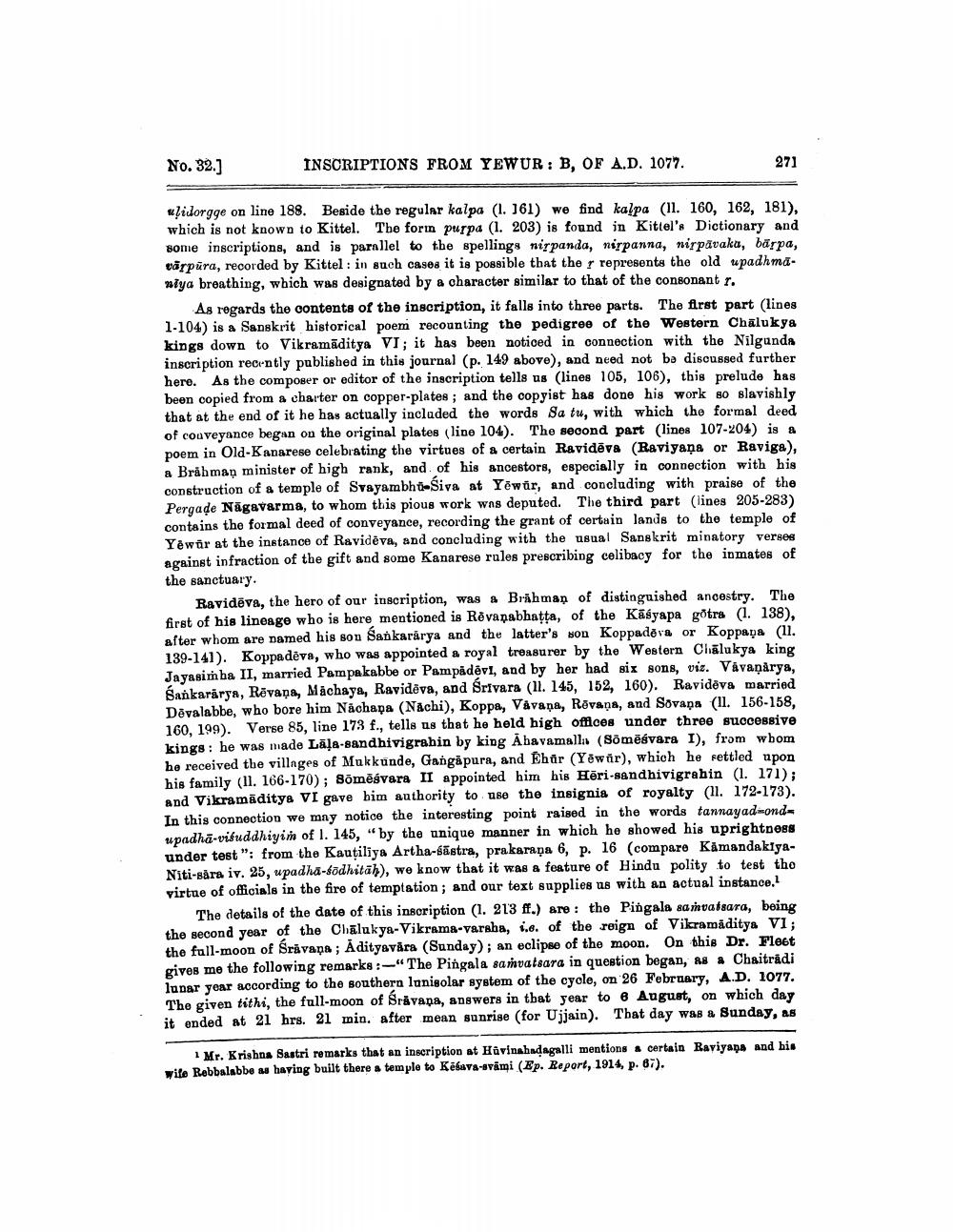________________
No. 32.]
INSCRIPTIONS FROM YEWUR: B, OF A.D. 1077.
271
kļidorgge on line 188. Beside the regular kalpa (1. 161) we find kalpa (11. 160, 162, 181), which is not known to Kittel. The forın purpa (1. 203) is found in Kittel's Dictionary and some inscriptions, and is parnllel to the spellings wirpanda, nirpanna, nirpävaku, bārpa, vārpūra, recorded by Kittel : in such cases it is possible that the r represents the old upadhmaniya breathing, which was designated by a character similar to that of the consonant r.
As regards the contents of the inscription, it falls into three parts. The first part (lines 1-104) is a Sanskrit historical poem recounting the pedigree of the Western Chalukya kings down to Vikramāditya VI; it has been noticed in connection with the Nilgunda inscription recently published in this journal (p. 149 above), and need not ba discussed further here. As the composer or editor of the inscription tells us (lines 105, 106), this prelude has been copied from a charter on copper-plates; and the copyist has done his work so slavishly that at the end of it he has actually included the words Sa tu, with which the formal deed of conveyance began on the original plates (line 104). The second part (lines 107-204) is a poem in Old-Kanarese celebrating the virtues of a certain Ravidēva (Raviyaņa or Raviga), a Brāhmaṇ minister of high rank, and of his ancestors, especially in connection with his construction of a temple of Svayambhu-Siva at Yewür, and concluding with praise of the Pergade Nāgavarma, to whom this pious work was deputed. The third part (lines 205-283) contains the formal deed of conveyance, recording the grant of certain lands to the temple of Yėwär at the instance of Ravidēva, and concluding with the usual Sanskrit minatory verses against infraction of the gift and some Kanarese rules prescribing celibacy for the inmates of the sanctuary.
Ravidēva, the hero of our inscription, was & Brahman of distinguished ancestry. The first of his lineage who is here mentioned is Rēvanabhatta, of the Kāsyapa gotra (1. 138), after whom are named his son Sankarărya and the latter's son Koppadēva or Koppapa (11. 139-141). Koppadeva, who was appointed a royal treasurer by the Western Chalukya king Jayasimha II, married Pampakabbe or Pampadēvi, and by her had six sons, viz. Våvaņårya, Sankarärya, Rövana, Michaya, Ravidēva, and Srivara (11. 145, 152, 160). Ravidēva married Dēvalabbe, who bore him Náchapa (Nächi), Koppa, Vávaņa, Rēvana, and Sovana (11. 156-158, 160, 199). Verse 85, line 173 f., tells us that he held high offices under three successive kings: he was made Laļa-sandhivigrahin by king Ābavamalla (Sõmēsvara I), from whom he received the villages of Mukkunde, Gangapura, and Ehår (Yewür), which he rettled upon his family (11. 166-170); Sömēsvara II appointed him his Hëri-sandhivigrahin (1. 171); and Vikramaditya VI gave him authority to use the insignia of royalty (11. 172-173). In this connection we mny notice the interesting point raised in the words tannayad-ondupadha-vifuddhiyin of I. 145, "by the unique manner in which he showed his uprightness under test": from the Kauţiliya Artha-fāstra, prakaraṇa 6, p. 16 (compare KamandakiyaNiti-såra iv. 25, upadha-sõdhitāh, we know that it was a feature of Hindu polity to test the virtue of officials in the fire of temptation; and our text supplies us with an actual instance.
The details of the date of this inscription (1. 213 ff.) are: the Pingala samvatsara, being the second year of the Chalukya-Vikrama-varaha, 1.c. of the reign of Vikramaditya VI; the full-moon of Srivaņa ; Adityavára (Sunday); an eclipse of the moon. On this Dr. Flest gives me the following remarks :-"The Pingala samvatsara in question began, as a Chaitrādi lunar year according to the southern lunigolar system of the cycle, on 26 February, A.D. 1077. The given tithi, the full-moon of Srävana, answers in that year to 8 August, on which day it ended at 21 hrs. 21 min. after mean sunrise (for Ujjain). That day was a Sunday, as
1 Mr. Krishna Sastri remarks that an inscription at Havinahndagalli mentions certain Raviyana and his ile Rebbolabbe as having built there a temple to Kėbava-svami (Ep. Report, 1914, p. 67).




